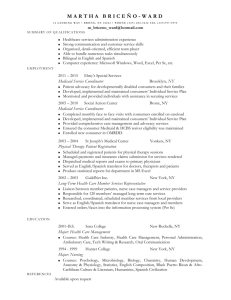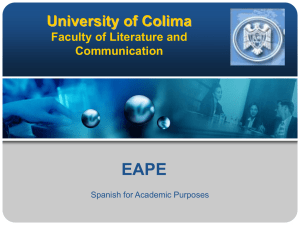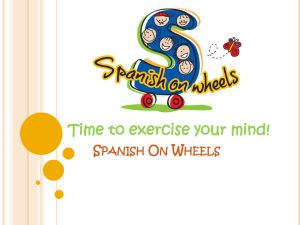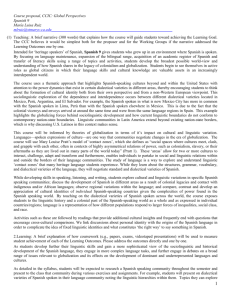Proposal
advertisement
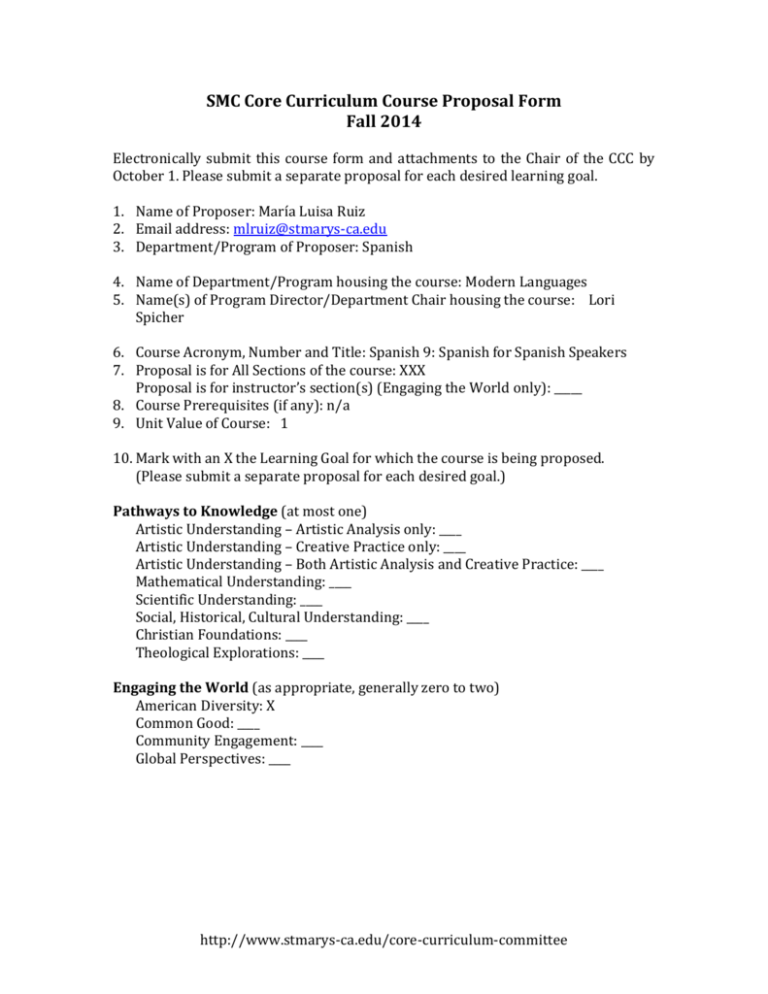
SMC Core Curriculum Course Proposal Form Fall 2014 Electronically submit this course form and attachments to the Chair of the CCC by October 1. Please submit a separate proposal for each desired learning goal. 1. Name of Proposer: María Luisa Ruiz 2. Email address: mlruiz@stmarys-ca.edu 3. Department/Program of Proposer: Spanish 4. Name of Department/Program housing the course: Modern Languages 5. Name(s) of Program Director/Department Chair housing the course: Lori Spicher 6. Course Acronym, Number and Title: Spanish 9: Spanish for Spanish Speakers 7. Proposal is for All Sections of the course: XXX Proposal is for instructor’s section(s) (Engaging the World only): _____ 8. Course Prerequisites (if any): n/a 9. Unit Value of Course: 1 10. Mark with an X the Learning Goal for which the course is being proposed. (Please submit a separate proposal for each desired goal.) Pathways to Knowledge (at most one) Artistic Understanding – Artistic Analysis only: ____ Artistic Understanding – Creative Practice only: ____ Artistic Understanding – Both Artistic Analysis and Creative Practice: ____ Mathematical Understanding: ____ Scientific Understanding: ____ Social, Historical, Cultural Understanding: ____ Christian Foundations: ____ Theological Explorations: ____ Engaging the World (as appropriate, generally zero to two) American Diversity: X Common Good: ____ Community Engagement: ____ Global Perspectives: ____ http://www.stmarys-ca.edu/core-curriculum-committee How does my class analyze aspects of social diversity? Teaching: Different dialects reflect different social groups with unique characteristics and histories. Often, these groups are also linked to different economic, cultural and social realities. Therefore, each particular dialect implies the assumption of specific socio-economic class. As I indicate in the original application, we stress that linguistic diversity can shape individual and collective identities within communities of U.S. Latinos with ties to countries in Latin America. While U.S. Spanish in itself, from the viewpoint of an outside viewer, can be understood as an expression of American Diversity in terms of a particular ethnic group, the very dialectical variations within it reveal more subtle markers that point to social categorizations. Therefore, while the use of an U.S. Spanish is, per se, an indicator of social diversity, it also reveals within itself the existence of socio-linguistic stratification. This course approaches the analysis of American Diversity from the inner core of the American Latino linguistic community, sorting the assumptions, classifications and social differentiations within the community as revealed by the use of language. Learning: Students can engage in questions about how dialectical varieties of Spanish tell us about how different communities define, and strive for social justice through language expression. Explain how social categories and structures of power may affect the human person (the individual). Teaching: Through language, different social strata are revealed. Linguistically, social diversity, as defined by dialects, creates layers within society. Therefore, the use of the language positions the individual within pre-determined social groups. For example, a Spanishspeaker who uses ‘pa’ instead of the full word “para” as in “voy para la tienda” (I am going to the store) instead of ‘voy pa’la tienda” is an example of a personals social, economic and education background. Among certain educated social communities among Spanish-speakers, the use of “pa” reveals perceived lack of education and the speaker’s cultural origin, which is in this case, is seen as rural, or working class and therefore uneducated. However, the majority of our students speak this way and the class highlights these differences as just that—linguistic differences related to one’s social position in society. Learning: As students develop communicative competence in reading, writing, speaking and listening and viewing, they learn about how language shapes the perception of the self and the other in a complex social environment. They also understand that language is a social construct. Explain how structures of power may affect the human person (individual). Teaching: Since language among Spanish speakers is an aspect of social structures in which power is at play, then linguistic expression is linked to social class. As the example above suggests, the class pays particular attention to the power dynamics that exist in certain dialectical varieties in different areas, thereby encouraging students to think about the formation of cultural and social identities vis-à-vis dialectical variation. The class http://www.stmarys-ca.edu/core-curriculum-committee addresses the conflicting structural and social forces that pressure speakers of a variety of Spanish to conform to a ‘standard’ (i.e. educated, middle class, urban Spanish as expressed in the media). Learning: Because the class describes dialectical varieties of Spanish in light of the twin phenomena of variation and change, students in Spanish 9 are able to express their individuality through distinctive language use. By touching on the dialectical varieties of Spanish spoken across the world, the course exposes students to the linguistic history and a colonial past of the Spanish-speaking world as a whole and as expressed in individual countries/regions; language is a representation of how different populations respond to larger forces of inequalities, social class, and race. The issue of U.S. Spanish becomes particularly relevant in the perspective of an American national language identity. The assignments for the class address these issues quite explicitly. Students develop communicative competence in reading, writing, speaking and listening and viewing, exploring topics and questions like: Which dialects carry more prestige than others? ; Can “Spanglish” be considered a dialectical variety of either Spanish or English?; Did the language ‘mix’ with indigenous languages?; what are unique characteristics of that language community?; what are well-known cultural ‘products’ produced by that language community (i.e. plays, music, movies)? . Students can also explore language attitudes, or research the growing influence of English in Spanish and the language community’s reaction to its presence or, they can research the ways in which their communities have struggled to keep Spanish as part of their cultural identity in the U.S. http://www.stmarys-ca.edu/core-curriculum-committee





